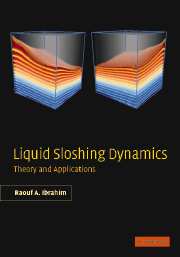
-
Select format
-
- Publisher:
- Cambridge University Press
- Publication date:
- 11 August 2009
- 19 May 2005
- ISBN:
- 9780511536656
- 9780521838856
- Dimensions:
- (247 x 174 mm)
- Weight & Pages:
- 2kg, 972 Pages
- Dimensions:
- Weight & Pages:
You may already have access via personal or institutional login
Book description
The problem of liquid sloshing in moving or stationary containers remains of great concern to aerospace, civil, and nuclear engineers; physicists; designers of road tankers and ship tankers; and mathematicians. Beginning with the fundamentals of liquid sloshing theory, this book takes the reader systematically from basic theory to advanced analytical and experimental results in a self-contained and coherent format. The book is divided into four sections. Part I deals with the theory of linear liquid sloshing dynamics; Part II addresses the nonlinear theory of liquid sloshing dynamics, Faraday waves, and sloshing impacts; Part III presents the problem of linear and nonlinear interaction of liquid sloshing dynamics with elastic containers and supported structures; and Part IV considers the fluid dynamics in spinning containers and microgravity sloshing. This book will be invaluable to researchers and graduate students in mechanical and aeronautical engineering, designers of liquid containers, and applied mathematicians.
Reviews
'This book will be invaluable to researchers and graduate students in mechanical and aeronautical engineering, designers of liquid containers and applied mathematicians.
Source: Engineering Designer
'…a remarkable and comprehensive contribution to sloshing dynamics… The reviewer highly recommends this book for graduates and Ph. D students in this field, as well as researchers and engineers in various industries that use storage tanks, because it contains not only original aspects but also acts as a tutorial through its discussions of how analytical results compare with measurements. It represents an important addition to the fluid-structure interaction bookshelf.'
Source: Journal of Sound and Vibration
Contents
Metrics
Altmetric attention score
Full text views
Full text views help Loading metrics...
Loading metrics...
* Views captured on Cambridge Core between #date#. This data will be updated every 24 hours.
Usage data cannot currently be displayed.
Accessibility standard: Unknown
Why this information is here
This section outlines the accessibility features of this content - including support for screen readers, full keyboard navigation and high-contrast display options. This may not be relevant for you.
Accessibility Information
Accessibility compliance for the PDF of this book is currently unknown and may be updated in the future.


